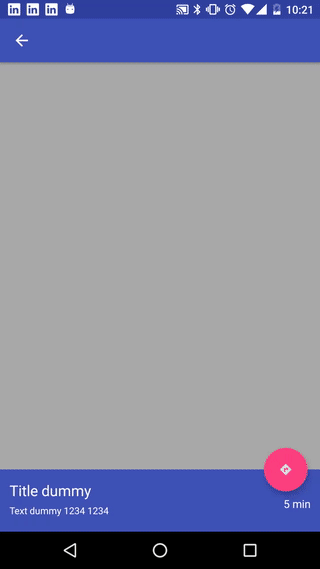BottomSheetDialogFragment - How to set expanded height (or min top offset)
AndroidAndroid Support-LibraryAndroiddesignsupportBottom SheetAndroid Problem Overview
I create a BottomSheetDialogFragment and I want to adjust it's maximum expanded height. How can I do that? I can retrieve the BottomSheetBehaviour but all I can find is a setter for the peek height but nothing for the expanded height.
public class DialogMediaDetails extends BottomSheetDialogFragment
{
@Override
public void setupDialog(Dialog dialog, int style)
{
super.setupDialog(dialog, style);
View view = View.inflate(getContext(), R.layout.dialog_media_details, null);
dialog.setContentView(view);
...
View bottomSheet = dialog.findViewById(R.id.design_bottom_sheet);
BottomSheetBehavior behavior = BottomSheetBehavior.from(bottomSheet);
behavior.setPeekHeight(...);
// how to set maximum expanded height???? Or a minimum top offset?
}
}
EDIT
Why do I need that? Because I show a BottomSheet Dialog in a full screen activity and it looks bad if the BottomSheet leaves a space on top...
Android Solutions
Solution 1 - Android
The height is being wrapped because the inflated view is added to the FrameLayout which has layout_height=wrap_content. See FrameLayout (R.id.design_bottom_sheet) at https://github.com/dandar3/android-support-design/blob/master/res/layout/design_bottom_sheet_dialog.xml.
The class below makes the bottom sheet full screen, background transparent, and fully expanded to the top.
public class FullScreenBottomSheetDialogFragment extends BottomSheetDialogFragment {
@CallSuper
@Override
public void onViewCreated(View view, @Nullable Bundle savedInstanceState) {
super.onViewCreated(view, savedInstanceState);
ButterKnife.bind(this, view);
}
@Override
public void onStart() {
super.onStart();
Dialog dialog = getDialog();
if (dialog != null) {
View bottomSheet = dialog.findViewById(R.id.design_bottom_sheet);
bottomSheet.getLayoutParams().height = ViewGroup.LayoutParams.MATCH_PARENT;
}
View view = getView();
view.post(() -> {
View parent = (View) view.getParent();
CoordinatorLayout.LayoutParams params = (CoordinatorLayout.LayoutParams) (parent).getLayoutParams();
CoordinatorLayout.Behavior behavior = params.getBehavior();
BottomSheetBehavior bottomSheetBehavior = (BottomSheetBehavior) behavior;
bottomSheetBehavior.setPeekHeight(view.getMeasuredHeight());
((View)bottomSheet.getParent()).setBackgroundColor(Color.TRANSPARENT)
});
}
}
--- EDIT Aug 30, 2018 --- I realized a year later that the background was colored on the wrong view. This dragged the background along with the content while a user was dragging the dialog. I fixed it so that the parent view of the bottom sheet is colored.
Solution 2 - Android
I found a much simpler answer; in your example where you obtain the FrameLayout for the bottom sheet using this code
View bottomSheet = dialog.findViewById(R.id.design_bottom_sheet);
you can then set the height on the layout params for that View to whatever height you want to set the expanded height to.
bottomSheet.getLayoutParams().height = ViewGroup.LayoutParams.MATCH_PARENT;
Solution 3 - Android
BIG UPDATE Avoiding duplicated code I'm giving a link to the full answer in where you can find all the explanations about how to get full behavior like Google Maps.
> I want to adjust its maximum expanded height. How can I do that?
Both BottomSheet and BottomSheetDialogFragment use a BottomSheetBehavior that you can found in Support Library 23.x
That Java class has 2 different uses for mMinOffset, one of them is used to define the area of the parent it will use to draw his content (maybe a NestedScrollView). And the other use is for defining the expanded anchor point, I mean, if you slide it up to form STATE_COLLAPSEDit will animate your BottomSheetuntil he reached this anchor point BUT if you can still keep sliding up to cover all parent height (CoordiantorLayout Height).
If you took a look at BottomSheetDialog you will see this method:
private View wrapInBottomSheet(int layoutResId, View view, ViewGroup.LayoutParams params) {
final CoordinatorLayout coordinator = (CoordinatorLayout) View.inflate(getContext(),
android.support.design.R.layout.design_bottom_sheet_dialog, null);
if (layoutResId != 0 && view == null) {
view = getLayoutInflater().inflate(layoutResId, coordinator, false);
}
FrameLayout bottomSheet = (FrameLayout) coordinator.findViewById(android.support.design.R.id.design_bottom_sheet);
BottomSheetBehavior.from(bottomSheet).setBottomSheetCallback(mBottomSheetCallback);
if (params == null) {
bottomSheet.addView(view);
} else {
bottomSheet.addView(view, params);
}
// We treat the CoordinatorLayout as outside the dialog though it is technically inside
if (shouldWindowCloseOnTouchOutside()) {
final View finalView = view;
coordinator.setOnTouchListener(new View.OnTouchListener() {
@Override
public boolean onTouch(View v, MotionEvent event) {
if (isShowing() &&
MotionEventCompat.getActionMasked(event) == MotionEvent.ACTION_UP &&
!coordinator.isPointInChildBounds(finalView,
(int) event.getX(), (int) event.getY())) {
cancel();
return true;
}
return false;
}
});
}
return coordinator;
}
No idea which one of those 2 behaviors you want but if you need the second one follow those steps:
-
Create a Java class and extend it from
CoordinatorLayout.Behavior<V> -
Copy paste code from the default
BottomSheetBehaviorfile to your new one. -
Modify the method
clampViewPositionVerticalwith the following code:@Override public int clampViewPositionVertical(View child, int top, int dy) { return constrain(top, mMinOffset, mHideable ? mParentHeight : mMaxOffset); } int constrain(int amount, int low, int high) { return amount < low ? low : (amount > high ? high : amount); } -
Add a new state
public static final int STATE_ANCHOR_POINT = X; -
Modify the next methods:
onLayoutChild,onStopNestedScroll,BottomSheetBehavior<V> from(V view)andsetState(optional)
And here is how it looks like
[ ]
]
Solution 4 - Android
Its works for me. Add code on BottomSheetDialogFragment's onViewCreated() methode
override fun onViewCreated(view: View, savedInstanceState: Bundle?) {
super.onViewCreated(view, savedInstanceState)
view.viewTreeObserver.addOnGlobalLayoutListener(object : ViewTreeObserver.OnGlobalLayoutListener {
override fun onGlobalLayout() {
view.viewTreeObserver.removeOnGlobalLayoutListener(this)
val dialog = dialog as BottomSheetDialog
val bottomSheet = dialog.findViewById<View>(com.google.android.material.R.id.design_bottom_sheet) as FrameLayout?
val behavior = BottomSheetBehavior.from(bottomSheet!!)
behavior.state = BottomSheetBehavior.STATE_EXPANDED
val newHeight = activity?.window?.decorView?.measuredHeight
val viewGroupLayoutParams = bottomSheet.layoutParams
viewGroupLayoutParams.height = newHeight ?: 0
bottomSheet.layoutParams = viewGroupLayoutParams
}
})
dialogView = view
}
Don't forget to remove viewTreeObserver.
override fun onDestroyView() {
dialogView?.viewTreeObserver?.addOnGlobalLayoutListener(null)
super.onDestroyView()
}
Solution 5 - Android
Get reference to sheet behavior,
private val behavior by lazy { (dialog as BottomSheetDialog).behavior }
turn fitToContents off and set expandedOffset to desired pixels.
behavior.isFitToContents = false
behavior.expandedOffset = 100
Solution 6 - Android
Kotlin
In my case I need to define a fixed height and I did the following:
val bottomSheet: View? = dialog.findViewById(R.id.design_bottom_sheet)
BottomSheetBehavior.from(bottomSheet!!).peekHeight = 250
this way you also have access to any property of the BottomSheetBehavior such as halfExpandedRatio
Solution 7 - Android
I would advise against using ids to find views. In the BottomSheetDialogFragment the dialog is a BottomSheetDialog which exposes the behavior for the bottom sheet. You can use that to set the peek height.
(dialog as BottomSheetDialog).behavior.peekHeight = ...